The following is part of a recent debate on facebook about Hirst’s Fish piece:
Matthew Collings included it in a Design album then contested its meaning especially with Paul Gladston. I joined in at this point.
Isolated Elements Swimming in the Same Direction for the Purpose of Understanding: 1992
I would like to put to one side the contest between ‘modernistic’ thinking and the ‘deconstructive’ approach ( I simplifying here but a brief read through the blurb for Mr Gladston’s book Art History after Deconstruction suggests he believes that it a false dichotomy and that deconstruction is essential to all art history (I am sure he will put me right if that a glib analysis). If we are looking at formal principles only then the most striking element for me is that firstly this piece is a reworking of the shark (1991-2) with smaller items which also echoes pharmacy and secondly that the fish selected are not native British species at all which suggests they imported. Lacking definitive knowledge of this ( the Gordon Burn book doesn’t tell) suggests that there is no order or meaning in the fish of themselves apart from a slightly exotic selection.
The Burn book shows that Hirst basically failed as a painter (he exhibited cardboard boxes covered in household paint at Freeze in docklands before he switched tack entirely)- the spot paintings revamped a Schwitters influenced colour collage phase he went through on Goldsmiths M.A. before leaping into the contained sculptures specifically the head and flies.
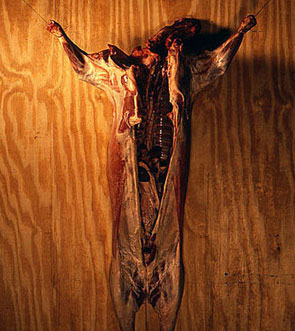
John LeKay. This is my body, this is my blood. 1987
John LeKay who Hirst finally met in 1992 had been doing similar work throughout mid- eighties and from then on Hirst pretty much apprenticed himself to LeKay in intellectual terms. A quick look through LeKay’s catalogue shows a far more interesting and thought out set of works. Indeed Hirst interviews LeKay in PIG magazine (LeKay’s magazine) and it master and pupil in tone. Hirst himself describes the change asputting a fucking box round everything after Cornell ( which where pharmacy taken from) .
Seen through the lens of a painter who influenced by Patrick Heron who was berated at Goldsmiths one can see that Hirst has never really succeeded in that area and that the spot paintings and swirls come from that and his lack of confidence as a painter…ending in the farcical Courtauld show which pretty much showed his ability starkly. However as a barrow boy he was fly enough to see that spectacle was required and he would fail with the paint/collage approach.. also those around him were succeeding in sculpture not painting and that what he provided. I agree with Matthew’s take on exhibitionism and display he tapped into a spectacular increase in office and retail space the Thatcher legacy of service and supply to me Hirst is a perfect analogy for an economy going through final post-empire convulsions. Just like his ‘fucking boxes’ the docklands he used for Freeze was contained and shipped and finally empty again LeKay and Hirst in that interview in Pig
- Damien Hirst: The work seems on the one hand to be very chaotic and on another level very organized
- John LeKay replies Well there is a definite order in chaos and an indefinite chaos comes out of order, is that what you mean? PIG 1993
Alone Yet Together containing 100 fish was created in 1993 and to me is a perfect example of organized chaos there is no order but that is presented in an ordered way hence the same direction. It could have been worms or birds..I even suspect that visual readings are irrelevant and that Hirst may have placed dark against light..etc but in the end does that really matter as the fish were probably sourced randomly even random placement can create harmonies just like collage.. It my belief that without Thatcherism….Saatchi and Craig Martin Hirst would be a provincial colourist of minor repute now but he surfed in on a flood of post Hong Kong money and power shifts. He will never be able to paint ….he could however put stuff in boxes.
Parts of the piece were broken up and sold individually so that to me negates any more profound structural approach and fits with his minimalist approach to effort.. http://www.independent.co.uk/arts-entertainment/art/news/hirst-hopes-to-revolutionise-art-market-with-golden-calf-851034.html?action=Gallery&ino=3
Hirst himself from Idler..
- HIRST: What I really like is minimum effort for maximum effect. Like with Picasso’s Bull’s Head a bike seat and handlebars making up the bull’s head. Such a brilliant thing because it takes that tiny amount of effort to create .
Hirst gave a fish shop in Leeds a fish. It was two years before Damien won the Turner Prize [in 1995] when he was just beginning to be a bit known.
We saw some publicity about a work of his, a whole lot of fish titled Isolated Elements Swimming in the Same Direction and we joked that it would be nice to get something like that for the shop.
That was a Trevally.. a Pacific predator. The unusual thing about the collection is they not the usual tropical fish ..has anybody analysed their types and reason he used them? The Shark was ordered and caught probably through Joplin maybe these were ordered too.
There were two cabinets source art newspaper online: –
- In 1991, the same year in which he made his original shark, Hirst did a series of sister works of fish in formaldehyde, which are amongst his most elegant natures mortes
- Isolated Elements Swimming in the Same Direction for the Purpose of Understanding, for example, consists of six rows of individually encased fish in two cabinets and was once described as a static ballet in an absurd movement toward nowhere.The first formaldehyde work to be shown in London (in a group show at the Serpentine), it too was purchased by Saatchi, travelled with ‘Sensation’, and then was bought back by Hirst in a £6m-for-12-works deal in 2004.
- Hirst continues to produce exquisite works of suspended fish. One of the most dignified pieces in the ‘Beautiful’ sale was a cruciform stainless steel cabinet containing fish skeletons on one side and fish in formaldehyde on the other. However, the ‘Beautiful’ sale also contained a near replica of the iconic Isolated Elements wall-piece titled Can’t Live With You, Can’t Live Without You. It had 12 shelves rather than six and the fish were smaller but, formally, it was the same work.
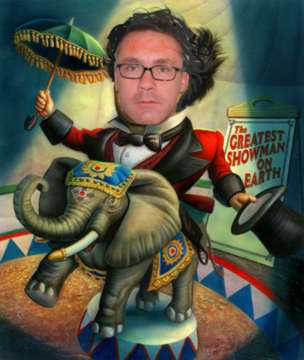
again Hirst puts it beautifully
- Am I a sculptor who wants to be a painter,he asks, or a cynical artist who thinks painting is now reduced to nothing more than a logo?..
Sorry Matthew but I firmly believe in the second statement ![]()
source: Sarah Thornton http://www.theartnewspaper.com/article.asp?id=16269
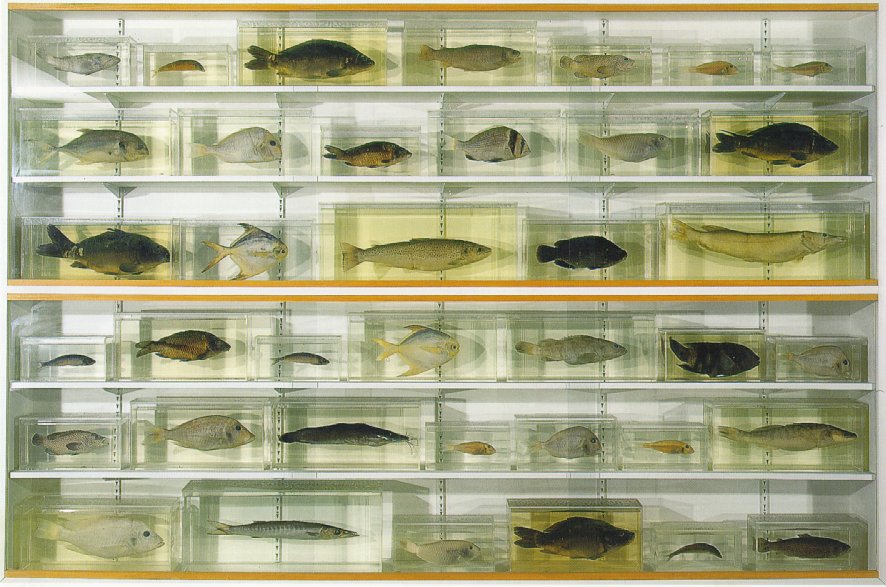
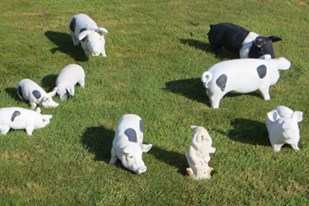
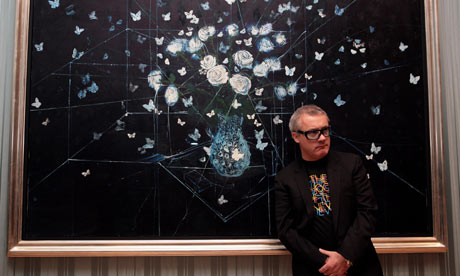
Recent Comments